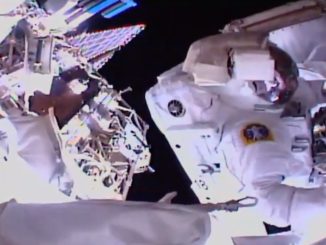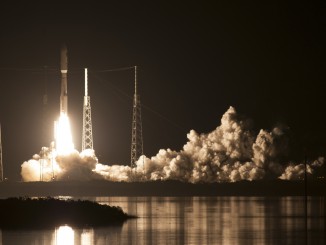
CAPE CANAVERAL — Four NASA satellites that will create a constellation of formation-flying spacecraft were placed aboard their shared United Launch Alliance Atlas 5 rocket Friday.
Liftoff of the Magnetospheric Multiscale mission, or MMS, is targeted for March 12 at 10:44 p.m. EDT (0244 GMT), the opening of a 30-minute nighttime launch opportunity.
Already encapsulated in the rocket’s 45-foot-long, 14-foot-diameter nose cone, the quartet of satellites traveled by road overnight, leaving Building 9 at the commercial Astrotech processing campus in Titusville at 1:30 a.m. and arriving at the Atlas 5 assembly hangar at Cape Canaveral’s Complex 41 at 4:13 a.m. EST.
Once at the building, dubbed the Vertical Integration Facility, crews went to work affixing a crane to the payload for hoisting atop the Atlas 5. MMS was lifted through the doorway and set aboard the Centaur upper stage to complete stacking of the 195-foot-tall rocket.
“The team is in high spirits and ready to get these technological marvels in space,” said Craig Tooley, MMS project manager at NASA’s Goddard Space Flight Center in Greenbelt, Maryland.
The rocket’s two stages, interstage and two solid boosters were assembled together in a sequence between Feb. 4 and Feb. 12, with the Centaur upper stage going up last.
Upcoming, ULA and NASA will run an integrated systems test that serves as a tip-to-tail electrical checkout of the combined rocket and satellites. Then the final closeouts of the various rocket compartments and fairing will occur to botton up the Atlas 5 for flight.
Rollout to the launch pad is slated for March 11, the day before liftoff. The countdown begins on launch day at 3:54 p.m. EDT, with fueling slated to start at 8:30 p.m. EDT.
It will be the 635th launch of an Atlas vehicle, the 341st from Cape Canaveral and the 201st Atlas-Centaur rocket.
The MMS mission will study the phenomenon of magnetic reconnection in Earth’s magnetosphere. It is an explosive process that scientists aren’t sure how it is triggered or why the next one will happen.
“Magnetic reconnection is the process of disconnecting or connecting the magnetic fields to each other, directing energy into the Earth on the day-side and letting it go on the night-side,” said Tom Moore, MMS senior project scientist.
“The interplay between those two is what produces all of the space weather around the Earth that can have big effects — can damage our spacecraft, hurt astronauts, upset the flow of electrical energy in our electrical grid on the surface of the Earth.”
See our earlier MMS coverage.
And see our Atlas archive for further information.



